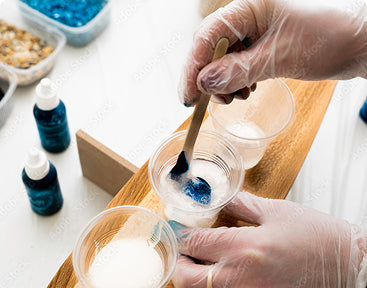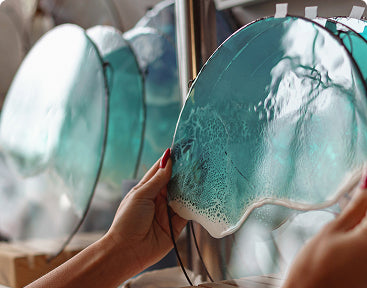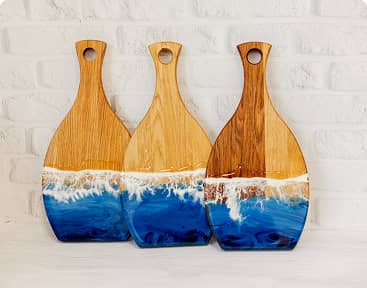Quality Assurance
We guarantee top-quality epoxy resin products that are made to achieve the highest safety standards with our food-safe resin coating, ensuring your peace of mind.
Picture this: your friends gather around your newly finished bar, running their hands across that flawless, glass-like surface while complimenting the stunning clarity that makes every detail in the wood grain pop. But here's the best part - six months later, after countless parties, spilled drinks, and daily use, it still looks absolutely perfect. That's exactly what Epoxy King's specialized bar coating systems deliver.
We've developed our complete bar top solutions after seeing too many enthusiastic customers struggle with inferior products or piece together incompatible components, only to end up with surfaces that can't handle the demanding conditions bars naturally face. Our professional-grade systems eliminate the guesswork by providing everything you need, ensuring your bar investment delivers the durability and beauty you deserve.
Bars take a beating that regular furniture simply doesn't experience. Think about what happens during a typical evening - cocktails with citrus acids, red wine that stains everything it touches, beer bottles sliding across the surface, and glasses being set down with enough force to crack lesser materials.
Then there's the cleaning aspect that most people don't fully consider until they're living with their finished bar. Commercial cleaners, bleach solutions for sanitizing, and the constant wiping with bar towels create an aggressive environment that demands exceptional chemical resistance. Your coating needs to maintain its crystal clear appearance despite this daily assault.






Chemical resistance stands as the most critical factor when selecting bar top epoxy resin for serious applications. Alcohol dissolves many standard finishes over time, while acidic mixers can etch or cloud inferior products. Professional formulations resist these substances while maintaining their clarity and smooth surface texture.Heat tolerance becomes essential when bartenders place hot coffee mugs directly on the surface or when heated serving dishes make contact. Quality bar coatings handle temperature fluctuations without softening, cracking, or developing permanent marks that compromise both appearance and functionality.
Crystal clear formulations showcase the natural beauty of wood while providing unmatched protection against daily wear. These specialized products cure completely transparent without the yellowing or cloudiness that cheaper alternatives often develop over time.
The self-leveling properties of premium clear epoxy create mirror-smooth surfaces that reflect light beautifully while eliminating the brush marks or application irregularities that can trap dirt and bacteria. This seamless finish makes cleaning effortless while maintaining that professional appearance that impresses guests.
Professional bar environments demand coatings that maintain their properties under constant use. Commercial formulations provide enhanced scratch resistance, superior chemical resistance, and the ability to withstand heavy traffic without showing wear patterns.
These heavy-duty systems often incorporate advanced chemistry that allows them to flex slightly under impact rather than cracking, making them ideal for busy bars where accidents happen regularly. The investment in commercial-grade materials pays dividends through reduced maintenance and longer service life.
Surface preparation determines the success or failure of any bar coating project. The wood must be completely clean, properly sanded, and sealed to prevent air bubbles from migrating through the coating during the curing process. Shortcuts in preparation inevitably show up as adhesion problems or surface defects.
Mixing precision becomes even more critical for bar applications because these surfaces face such demanding conditions. Even small deviations from recommended ratios can compromise chemical resistance or final hardness. Professional measuring tools eliminate guesswork while ensuring optimal performance characteristics.
Temperature control during application affects both working time and final properties. Cold conditions slow curing reactions and may prevent complete hardening, while excessive heat reduces working time and can cause application problems. Planning around favorable weather conditions improves results significantly.
Humidity considerations become particularly important for bar applications because moisture can interfere with certain hardener types, potentially affecting chemical resistance. Understanding these environmental factors helps schedule application timing for optimal curing conditions.
Bar countertops often connect to other surfaces, requiring careful planning to ensure smooth transitions and consistent appearance. Professional techniques create seamless joints between sections while maintaining the structural integrity needed for heavy use.
Color options and decorative elements can transform ordinary bar surfaces into stunning focal points. Metallic powders, pigments, and artistic techniques like resin art create custom effects while maintaining the durability required for functional surfaces. These creative approaches require understanding how additives affect curing and performance.
Routine cleaning with appropriate products maintains the appearance and protective properties of quality bar coatings. Mild soap and water handle most situations, while specialized cleaners address stubborn stains without damaging the surface. Understanding proper care procedures extends service life significantly.
Periodic inspection helps identify minor issues before they become major problems. Small scratches or minor damage often accept spot repairs using compatible materials, preventing the need for complete refinishing. Early intervention saves both time and money while maintaining appearance.
Temperature tolerance specifications guide appropriate use and help prevent damage from hot items. Most quality bar coatings handle normal serving temperatures without problems, though understanding limits prevents accidental damage from extremely hot items.
Chemical compatibility charts help identify which substances the coating can handle safely and which might cause problems. This information guides both daily use and cleaning product selection, ensuring the surface maintains its properties over time.
Skill requirements vary significantly between simple residential bars and complex commercial installations. Basic home bar projects suit many DIY enthusiasts, while large commercial bars or intricate designs may benefit from professional installation to ensure optimal results.
Tool investments for bar projects often justify themselves through improved results and the ability to handle future projects. Quality measuring equipment, mixing tools, and application accessories contribute to professional outcomes while building capabilities for additional work.
Our bar-specific kits include everything needed for successful installations, from precisely measured materials to detailed instructions. This eliminates compatibility concerns while ensuring adequate supplies for proper application thickness and coverage.
Cost effectiveness comes from buying matched components designed to work together rather than attempting to source individual items separately. Kit pricing typically provides significant savings while eliminating the risk of missing critical components when you're ready to start mixing.
Ventilation requirements become particularly important when working in enclosed spaces or areas where people will be present during curing. Adequate airflow protects both applicator health and ensures optimal curing conditions for the best possible results.
Food safety considerations may apply to bars that serve food, requiring materials that meet appropriate standards for indirect food contact. Understanding these requirements helps select suitable products for specific applications and ensures compliance with local health codes.
Cloudiness or hazing often results from moisture contamination, incomplete mixing, or environmental conditions during application. Prevention through proper technique and environmental control works much better than attempting corrections after problems develop.
Surface defects like orange peel texture or uneven gloss typically stem from application technique issues or environmental factors. Understanding quality control procedures prevents most surface problems while identifying solutions when issues do occur.
Project assessment should consider surface area, expected use intensity, and aesthetic goals when choosing appropriate products. Home bars have different requirements than commercial installations, though both benefit from quality materials and proper application techniques.
Budget planning includes material costs, tool requirements, and potential professional assistance for complex projects. Complete systems often provide better value than purchasing components separately, especially when factoring in the cost of mistakes or inadequate materials.
Quality bar coatings maintain their appearance and protective properties for decades when properly applied and maintained. This longevity makes premium materials cost-effective compared to frequent refinishing with lesser products.
Property value considerations make bar improvements worthwhile investments, particularly when using materials and techniques that create professional-quality results. Well-executed bar surfaces become selling points that distinguish properties in competitive markets.

We guarantee top-quality epoxy resin products that are made to achieve the highest safety standards with our food-safe resin coating, ensuring your peace of mind.

With years of experience in the industry, we have the knowledge and expertise to provide you with the best solutions for your food-safe projects.

Our extensive range of epoxy resin products offers options for every need and budget, ensuring that you find the perfect fit for your project.

At Epoxy King, customer satisfaction is our priority. We strive to exceed your expectations with our products and service, earning your trust and loyalty.

When you choose Epoxy King, you can count on reliable products and dependable service every time. Trust us for all your food-safe epoxy needs and experience the difference.
Here’s a comprehensive FAQ that covers various aspects
Most bar applications work well with 1/8 to 1/4 inch thickness, providing adequate protection while maintaining reasonable material costs. This thickness range offers excellent durability against daily wear while ensuring proper curing without excessive heat buildup. Thicker applications around 3/8 inch can provide enhanced impact resistance and a more substantial glass-like appearance, but require careful attention to heat management during curing and significantly increase material costs.
Very thin applications under 1/8 inch may not provide adequate protection for high-traffic bar surfaces and can be more difficult to achieve uniform coverage. The key is matching thickness to your specific use requirements - home bars might work perfectly at 1/8 inch, while commercial applications often benefit from the enhanced durability of 1/4 inch thickness.
While epoxy surfaces are very durable, they're not intended as cutting surfaces and direct cutting will eventually show marks and may compromise the protective barrier. Knife blades can create fine scratches that accumulate over time, dulling the surface clarity that makes epoxy so appealing. More aggressive chopping with heavy knives or cleavers can create deeper gouges that are difficult or impossible to repair without refinishing sections of the surface. The hardness that makes epoxy excellent for protection also makes it unforgiving when subjected to sharp impacts.
Using cutting boards protects the coating while maintaining its appearance indefinitely. Consider installing a dedicated cutting board insert or removable cutting station if food preparation will be a regular activity at your bar. For emergency situations where you absolutely must cut something directly on the surface, use the lightest pressure possible and clean immediately to prevent staining. Remember that most bar tops are designed for serving and entertaining rather than food preparation, so planning your workflow around appropriate cutting surfaces will preserve your investment for decades.
Light use is typically possible after 24-48 hours, but full cure and maximum chemical resistance develop over 7 days. Avoiding heavy use and chemical exposure during this period ensures optimal final properties.
Small scratches often polish out with appropriate compounds, while deeper damage may require spot repairs using compatible materials. The key is addressing problems early before they worsen or compromise surrounding areas.
Mild soap and water handle routine cleaning effectively. Avoid harsh chemicals, abrasive cleaners, or anything containing ammonia, which can cloud some epoxy formulations over time.
Yes, but additives must be compatible with the base system and used according to manufacturer guidelines. Some colorants or decorative elements can affect curing or final properties if used incorrectly.
Proper surface preparation, correct mixing technique, and appropriate environmental conditions prevent most bubble problems. Working in thin layers and using proper application tools also helps minimize air entrapment.
Most quality systems handle temperatures up to 190°F without damage, though prolonged contact with very hot items may leave marks. Using trivets or coasters for hot items prevents potential problems.
Whether you're building a home entertainment space or outfitting a commercial establishment, our specialized bar coating systems provide the durability and appearance you need. Starting with quality materials and proper guidance ensures your investment delivers the professional results that make every gathering memorable.
